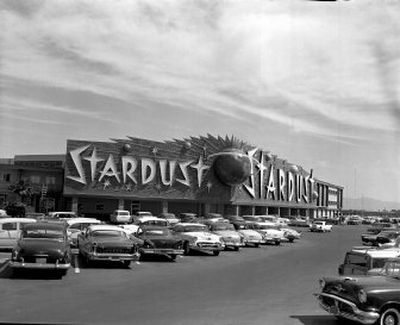Las Vegas pioneer hits the end of the trail

LAS VEGAS — When the Stardust hotel opened on July 2, 1958, it was billed as the largest resort in the world, but was described in press reports as little more than a warehouse with a lot of slot machines and rooms.
It never appealed to the upscale audiences that are courted now on the ever-more luxurious Las Vegas Strip; $5-a-night rooms and a free $5 to gamble was what founder Tony Cornero had in mind to attract the masses.
The casino that helped define Las Vegas’ neon age was overrun by more successful nearby properties as gamblers began to show a willingness to pay more for rooms, food and drinks that once were loss-leading draws to the casino floor.
Now, nearly 50 years later, the once-mob-backed institution is closing its doors for good, to make way for a hipper, more glamorous crowd and owner Boyd Gaming Corp.’s $4 billion Echelon Place resort.
“I can understand throwing it out for something new,” said Don Burt, a Chicago resident playing the horses in the Stardust’s once-legendary sports book in the last days before the resort closed. “It’s like a shoe. It’s real comfortable, but it’s getting worn.”
In its heyday, the Stardust paved the way for the famous gambling corridor’s glitziest era, and its design skipped the fountains, spacious lawns and driveway entries common at most of its contemporaries.
Its landmark marquee hawked the town’s first topless stage production, “Lido de Paris,” as well as an eye-popping $100,000 limit on sports wagers that drew bettors small and large.
“The Stardust’s exterior was certainly iconic,” said David Schwartz, director of the Center for Gaming Research at the University of Nevada, Las Vegas. “(It) helped to define the high neon age of the city, which spanned the mid-1960s to 1980s.”
The casino featured the only first-run drive-in theater in Las Vegas and a rodeo arena at the back of the property.
The Stardust also served as a lasting tribute to the mob.
Reputed gangsters Moe Dalitz and Allan Roen took over the casino construction project in 1958 after a lengthy legal squabble following Cornero’s death three years earlier. With the help of financial backer Jack “the Barber” Factor, the $10 million casino opened with 1,065 rooms.
And though it occupies what is now considered the north end of the Strip, in the 1970s, bartender Denny Onofrio says, it was at its heart.
Elvis Presley, poker players like Amarillo Slim, Johnny Moss and Nick the Greek showed up. Running back Jim Brown hosted a radio show on the property. Even New York Yankees great Joe DiMaggio once sat unassumingly at the bar, drinking beer.
“I’m telling everybody, ‘Hey, that’s Joe D. down there,’ ” Onofrio said. “He didn’t like that. He said, ‘Look, I’ll give you an autograph, but quit telling everybody who I am.’ ”
In the late 1970s, the federal government and state of Nevada moved to squeeze the mob out of Las Vegas and attempted to dry up its cash resources.
The mob’s control of the Stardust began to unravel in 1984 when the Nevada Gaming Commission socked it with a $3 million fine, at the time the stiffest ever, after a long investigation into skimming. Ultimately, nine men were convicted and sent to prison.
At the request of Nevada regulators, Sam Boyd and his son, Bill, were brought in to run the noncasino operations in 1983, and then to buy the entire property in 1985.
Boyd Gaming Chairman Bill Boyd said trying to manage the casino with the mob was one of the most unpleasant experiences of his life, but credits gangsters with setting the city’s foundation.
“The ironic thing is Las Vegas would not be Las Vegas today if it weren’t for the mob,” he said. “They loaned money when the banks wouldn’t. They got Las Vegas started.”
Since then, Boyd Gaming has spent more than $300 million on the Stardust and expanded it to include 2,100 rooms, a 100,000-square-foot casino, a 25,000-square-foot conference center and two landscaped swimming pools.
Boyd has said a room probably will be created in Echelon Place to preserve memorabilia from the casino’s stellar 48 years.
Onofrio keeps his own mementos — including the Stardust notepad that DiMaggio signed.
“You know what? It’s going to be sad, but it’s time,” Onofrio said. “We have to move on.”